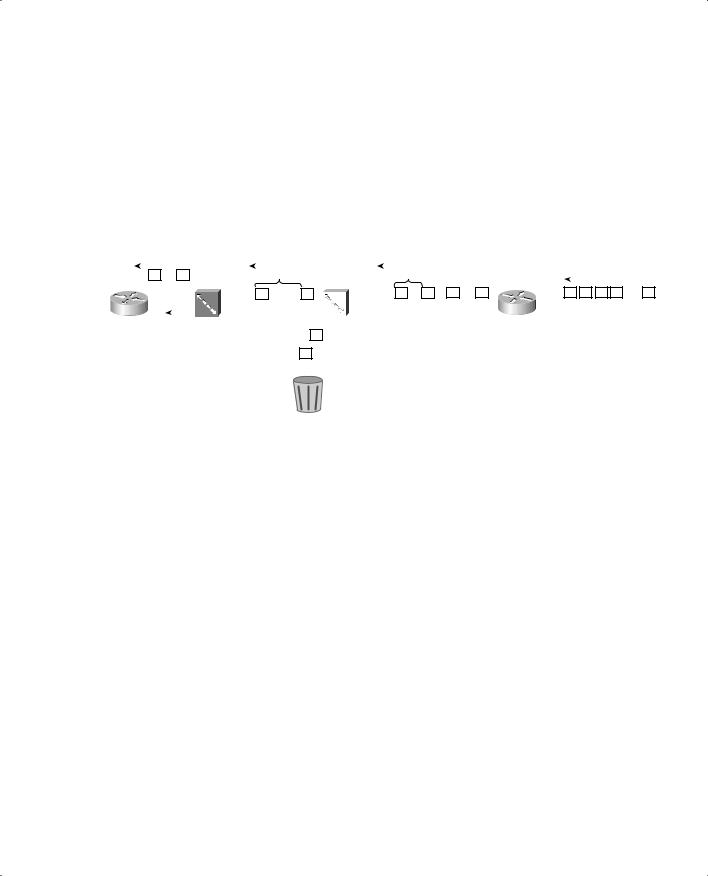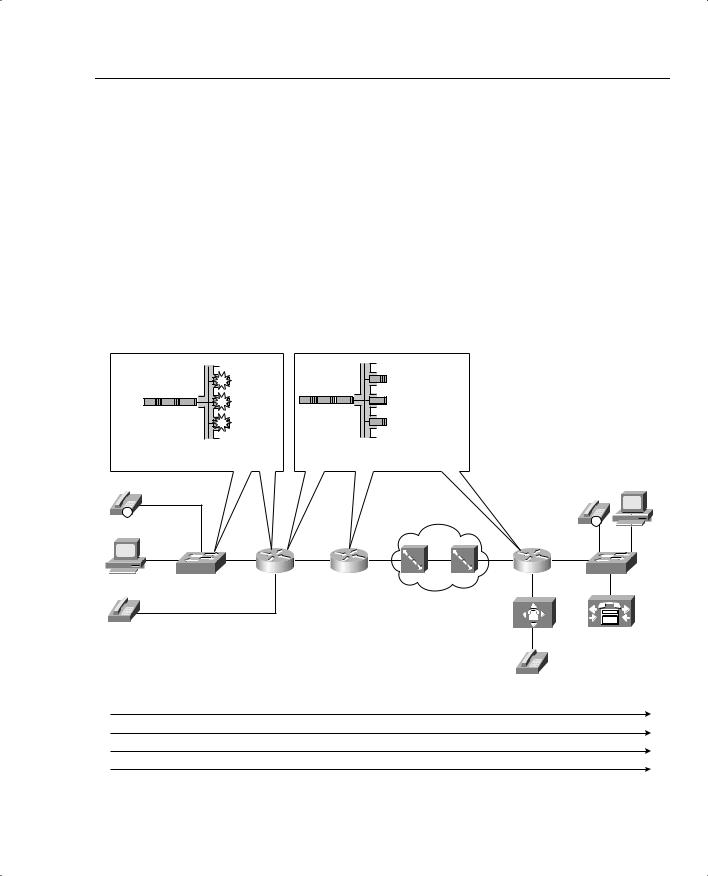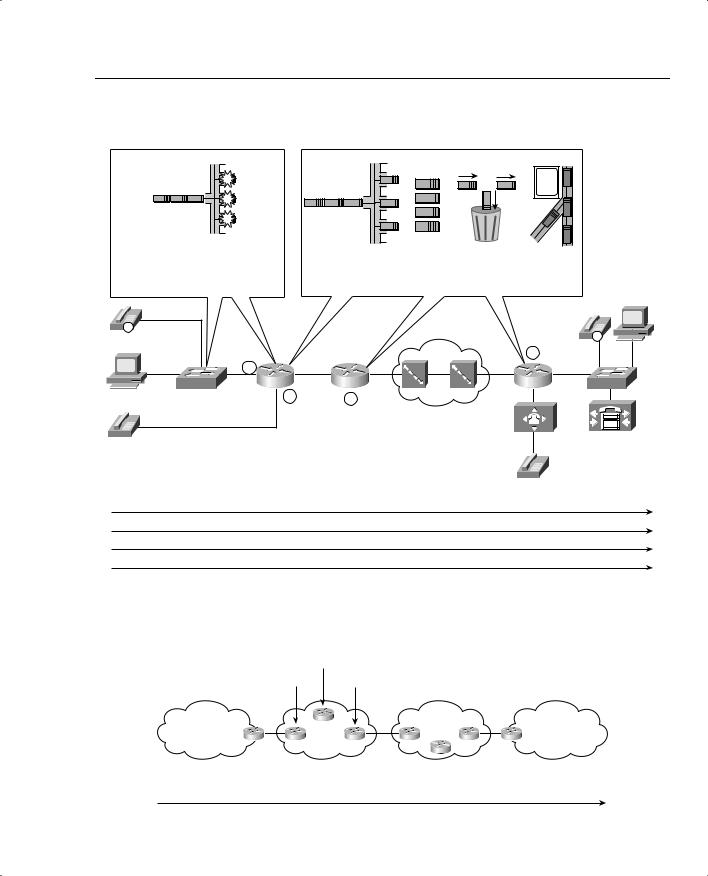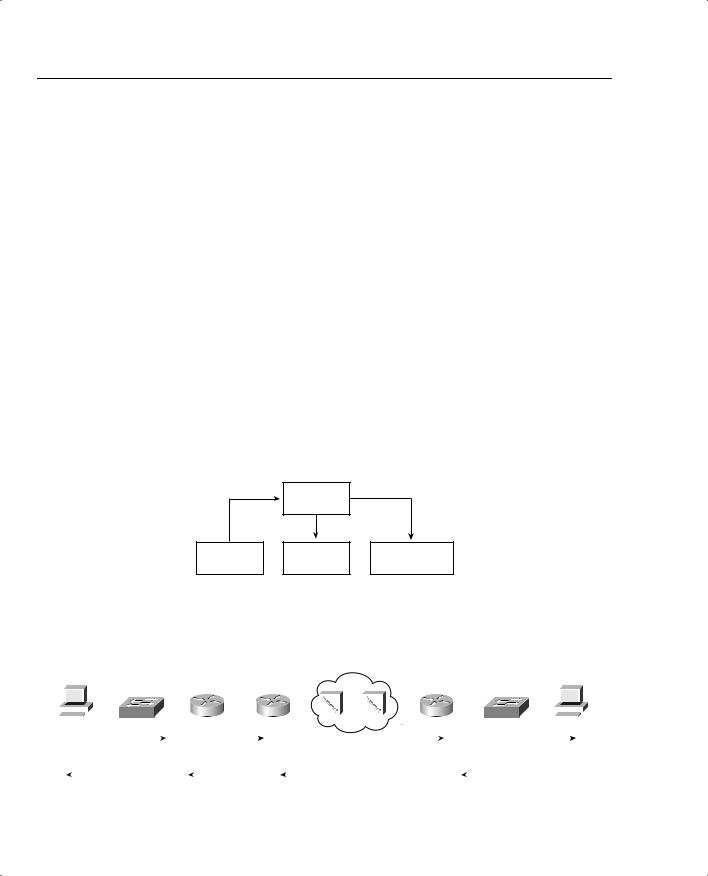
- •QoS Overview
- •“Do I Know This Already?” Quiz
- •QoS: Tuning Bandwidth, Delay, Jitter, and Loss Questions
- •Foundation Topics
- •QoS: Tuning Bandwidth, Delay, Jitter, and Loss
- •Bandwidth
- •The clock rate Command Versus the bandwidth Command
- •QoS Tools That Affect Bandwidth
- •Delay
- •Serialization Delay
- •Propagation Delay
- •Queuing Delay
- •Forwarding Delay
- •Shaping Delay
- •Network Delay
- •Delay Summary
- •QoS Tools That Affect Delay
- •Jitter
- •QoS Tools That Affect Jitter
- •Loss
- •QoS Tools That Affect Loss
- •Summary: QoS Characteristics: Bandwidth, Delay, Jitter, and Loss
- •Voice Basics
- •Voice Bandwidth Considerations
- •Voice Delay Considerations
- •Voice Jitter Considerations
- •Voice Loss Considerations
- •Video Basics
- •Video Bandwidth Considerations
- •Video Delay Considerations
- •Video Jitter Considerations
- •Video Loss Considerations
- •Comparing Voice and Video: Summary
- •IP Data Basics
- •Data Bandwidth Considerations
- •Data Delay Considerations
- •Data Jitter Considerations
- •Data Loss Considerations
- •Comparing Voice, Video, and Data: Summary
- •Foundation Summary
- •QoS Tools and Architectures
- •“Do I Know This Already?” Quiz
- •QoS Tools Questions
- •Differentiated Services Questions
- •Integrated Services Questions
- •Foundation Topics
- •Introduction to IOS QoS Tools
- •Queuing
- •Queuing Tools
- •Shaping and Policing
- •Shaping and Policing Tools
- •Congestion Avoidance
- •Congestion-Avoidance Tools
- •Call Admission Control and RSVP
- •CAC Tools
- •Management Tools
- •Summary
- •The Good-Old Common Sense QoS Model
- •GOCS Flow-Based QoS
- •GOCS Class-Based QoS
- •The Differentiated Services QoS Model
- •DiffServ Per-Hop Behaviors
- •The Class Selector PHB and DSCP Values
- •The Assured Forwarding PHB and DSCP Values
- •The Expedited Forwarding PHB and DSCP Values
- •The Integrated Services QoS Model
- •Foundation Summary
- •“Do I Know This Already?” Quiz Questions
- •CAR, PBR, and CB Marking Questions
- •Foundation Topics
- •Marking
- •IP Header QoS Fields: Precedence and DSCP
- •LAN Class of Service (CoS)
- •Other Marking Fields
- •Summary of Marking Fields
- •Class-Based Marking (CB Marking)
- •Network-Based Application Recognition (NBAR)
- •CB Marking show Commands
- •CB Marking Summary
- •Committed Access Rate (CAR)
- •CAR Marking Summary
- •Policy-Based Routing (PBR)
- •PBR Marking Summary
- •VoIP Dial Peer
- •VoIP Dial-Peer Summary
- •Foundation Summary
- •Congestion Management
- •“Do I Know This Already?” Quiz
- •Queuing Concepts Questions
- •WFQ and IP RTP Priority Questions
- •CBWFQ and LLQ Questions
- •Comparing Queuing Options Questions
- •Foundation Topics
- •Queuing Concepts
- •Output Queues, TX Rings, and TX Queues
- •Queuing on Interfaces Versus Subinterfaces and Virtual Circuits (VCs)
- •Summary of Queuing Concepts
- •Queuing Tools
- •FIFO Queuing
- •Priority Queuing
- •Custom Queuing
- •Weighted Fair Queuing (WFQ)
- •WFQ Scheduler: The Net Effect
- •WFQ Scheduling: The Process
- •WFQ Drop Policy, Number of Queues, and Queue Lengths
- •WFQ Summary
- •Class-Based WFQ (CBWFQ)
- •CBWFQ Summary
- •Low Latency Queuing (LLQ)
- •LLQ with More Than One Priority Queue
- •IP RTP Priority
- •Summary of Queuing Tool Features
- •Foundation Summary
- •Conceptual Questions
- •Priority Queuing and Custom Queuing
- •CBWFQ, LLQ, IP RTP Priority
- •Comparing Queuing Tool Options
- •“Do I Know This Already?” Quiz
- •Shaping and Policing Concepts Questions
- •Policing with CAR and CB Policer Questions
- •Shaping with FRTS, GTS, DTS, and CB Shaping
- •Foundation Topics
- •When and Where to Use Shaping and Policing
- •How Shaping Works
- •Where to Shape: Interfaces, Subinterfaces, and VCs
- •How Policing Works
- •CAR Internals
- •CB Policing Internals
- •Policing, but Not Discarding
- •Foundation Summary
- •Shaping and Policing Concepts
- •“Do I Know This Already?” Quiz
- •Congestion-Avoidance Concepts and RED Questions
- •WRED Questions
- •FRED Questions
- •Foundation Topics
- •TCP and UDP Reactions to Packet Loss
- •Tail Drop, Global Synchronization, and TCP Starvation
- •Random Early Detection (RED)
- •Weighted RED (WRED)
- •How WRED Weights Packets
- •WRED and Queuing
- •WRED Summary
- •Flow-Based WRED (FRED)
- •Foundation Summary
- •Congestion-Avoidance Concepts and Random Early Detection (RED)
- •Weighted RED (WRED)
- •Flow-Based WRED (FRED)
- •“Do I Know This Already?” Quiz
- •Compression Questions
- •Link Fragmentation and Interleave Questions
- •Foundation Topics
- •Payload and Header Compression
- •Payload Compression
- •Header Compression
- •Link Fragmentation and Interleaving
- •Multilink PPP LFI
- •Maximum Serialization Delay and Optimum Fragment Sizes
- •Frame Relay LFI Using FRF.12
- •Choosing Fragment Sizes for Frame Relay
- •Fragmentation with More Than One VC on a Single Access Link
- •FRF.11-C and FRF.12 Comparison
- •Foundation Summary
- •Compression Tools
- •LFI Tools
- •“Do I Know This Already?” Quiz
- •Foundation Topics
- •Call Admission Control Overview
- •Call Rerouting Alternatives
- •Bandwidth Engineering
- •CAC Mechanisms
- •CAC Mechanism Evaluation Criteria
- •Local Voice CAC
- •Physical DS0 Limitation
- •Max-Connections
- •Voice over Frame Relay—Voice Bandwidth
- •Trunk Conditioning
- •Local Voice Busyout
- •Measurement-Based Voice CAC
- •Service Assurance Agents
- •SAA Probes Versus Pings
- •SAA Service
- •Calculated Planning Impairment Factor
- •Advanced Voice Busyout
- •PSTN Fallback
- •SAA Probes Used for PSTN Fallback
- •IP Destination Caching
- •SAA Probe Format
- •PSTN Fallback Scalability
- •PSTN Fallback Summary
- •Resource-Based CAC
- •Resource Availability Indication
- •Gateway Calculation of Resources
- •RAI in Service Provider Networks
- •RAI in Enterprise Networks
- •RAI Operation
- •RAI Platform Support
- •Cisco CallManager Resource-Based CAC
- •Location-Based CAC Operation
- •Locations and Regions
- •Calculation of Resources
- •Automatic Alternate Routing
- •Location-Based CAC Summary
- •Gatekeeper Zone Bandwidth
- •Gatekeeper Zone Bandwidth Operation
- •Single-Zone Topology
- •Multizone Topology
- •Zone-per-Gateway Design
- •Gatekeeper in CallManager Networks
- •Zone Bandwidth Calculation
- •Gatekeeper Zone Bandwidth Summary
- •Integrated Services / Resource Reservation Protocol
- •RSVP Levels of Service
- •RSVP Operation
- •RSVP/H.323 Synchronization
- •Bandwidth per Codec
- •Subnet Bandwidth Management
- •Monitoring and Troubleshooting RSVP
- •RSVP CAC Summary
- •Foundation Summary
- •Call Admission Control Concepts
- •Local-Based CAC
- •Measurement-Based CAC
- •Resources-Based CAC
- •“Do I Know This Already?” Quiz
- •QoS Management Tools Questions
- •QoS Design Questions
- •Foundation Topics
- •QoS Management Tools
- •QoS Device Manager
- •QoS Policy Manager
- •Service Assurance Agent
- •Internetwork Performance Monitor
- •Service Management Solution
- •QoS Management Tool Summary
- •QoS Design for the Cisco QoS Exams
- •Four-Step QoS Design Process
- •Step 1: Determine Customer Priorities/QoS Policy
- •Step 2: Characterize the Network
- •Step 3: Implement the Policy
- •Step 4: Monitor the Network
- •QoS Design Guidelines for Voice and Video
- •Voice and Video: Bandwidth, Delay, Jitter, and Loss Requirements
- •Voice and Video QoS Design Recommendations
- •Foundation Summary
- •QoS Management
- •QoS Design
- •“Do I Know This Already?” Quiz
- •Foundation Topics
- •The Need for QoS on the LAN
- •Layer 2 Queues
- •Drop Thresholds
- •Trust Boundries
- •Cisco Catalyst Switch QoS Features
- •Catalyst 6500 QoS Features
- •Supervisor and Switching Engine
- •Policy Feature Card
- •Ethernet Interfaces
- •QoS Flow on the Catalyst 6500
- •Ingress Queue Scheduling
- •Layer 2 Switching Engine QoS Frame Flow
- •Layer 3 Switching Engine QoS Packet Flow
- •Egress Queue Scheduling
- •Catalyst 6500 QoS Summary
- •Cisco Catalyst 4500/4000 QoS Features
- •Supervisor Engine I and II
- •Supervisor Engine III and IV
- •Cisco Catalyst 3550 QoS Features
- •Cisco Catalyst 3524 QoS Features
- •CoS-to-Egress Queue Mapping for the Catalyst OS Switch
- •Layer-2-to-Layer 3 Mapping
- •Connecting a Catalyst OS Switch to WAN Segments
- •Displaying QoS Settings for the Catalyst OS Switch
- •Enabling QoS for the Catalyst IOS Switch
- •Enabling Priority Queuing for the Catalyst IOS Switch
- •CoS-to-Egress Queue Mapping for the Catalyst IOS Switch
- •Layer 2-to-Layer 3 Mapping
- •Connecting a Catalyst IOS Switch to Distribution Switches or WAN Segments
- •Displaying QoS Settings for the Catalyst IOS Switch
- •Foundation Summary
- •LAN QoS Concepts
- •Catalyst 6500 Series of Switches
- •Catalyst 4500/4000 Series of Switches
- •Catalyst 3550/3524 Series of Switches
- •QoS: Tuning Bandwidth, Delay, Jitter, and Loss
- •QoS Tools
- •Differentiated Services
- •Integrated Services
- •CAR, PBR, and CB Marking
- •Queuing Concepts
- •WFQ and IP RTP Priority
- •CBWFQ and LLQ
- •Comparing Queuing Options
- •Conceptual Questions
- •Priority Queuing and Custom Queuing
- •CBWFQ, LLQ, IP RTP Priority
- •Comparing Queuing Tool Options
- •Shaping and Policing Concepts
- •Policing with CAR and CB Policer
- •Shaping with FRTS, GTS, DTS, and CB Shaping
- •Shaping and Policing Concepts
- •Congestion-Avoidance Concepts and RED
- •WRED
- •FRED
- •Congestion-Avoidance Concepts and Random Early Detection (RED)
- •Weighted RED (WRED)
- •Flow-Based WRED (FRED)
- •Compression
- •Link Fragmentation and Interleave
- •Compression Tools
- •LFI Tools
- •Call Admission Control Concepts
- •Local-Based CAC
- •Measurement-Based CAC
- •Resources-Based CAC
- •QoS Management Tools
- •QoS Design
- •QoS Management
- •QoS Design
- •LAN QoS Concepts
- •Catalyst 6500 Series of Switches
- •Catalyst 4500/4000 Series of Switches
- •Catalyst 3550/3524 Series of Switches
- •Foundation Topics
- •QPPB Route Marking: Step 1
- •QPPB Per-Packet Marking: Step 2
- •QPPB: The Hidden Details
- •QPPB Summary
- •Flow-Based dWFQ
- •ToS-Based dWFQ
- •Distributed QoS Group–Based WFQ
- •Summary: dWFQ Options

Foundation Summary 137
Foundation Summary
The “Foundation Summary” is a collection of tables and figures that provide a convenient review of many key concepts in this chapter. For those of you already comfortable with the topics in this chapter, this summary could help you recall a few details. For those of you who just read this chapter, this review should help solidify some key facts. For any of you doing your final prep before the exam, these tables and figures are a convenient way to review the day before the exam.
Table 2-21 lists the IOS classification and marking tools, along with a few key features that differentiate the tools.
Table 2-21 Comparison of Classification and Marking Tools
|
Other Functions |
Fields That Can |
|
|
Besides Class and |
Be Examined for |
Fields That Can |
Tool |
Mark |
Classification |
Be Marked* |
|
|
|
|
Policy-based routing |
Routing packets based on |
ACLs indirectly through |
IP ToS field |
(PBR) |
something besides desti- |
route maps |
IP Precedence field |
|
nation address |
|
|
|
|
QoS Group |
|
|
|
|
|
|
|
|
|
Committed access |
Policing |
IP ACLs |
IP Precedence |
rate (CAR) |
|
QoS Group |
IP DSCP |
|
|
||
|
|
IP DSCP |
QoS Group |
|
|
|
MPLS Experimental |
|
|
|
|
Class-based marking |
None |
IP ACLs |
IP precedence |
(CB marking) |
|
Any markable fields |
DSCP |
|
|
||
|
|
Input interface |
802.1P CoS |
|
|
MAC addresses |
ISL Priority |
|
|
All NBAR-enabled fields |
ATM CLP |
|
|
|
Frame Relay DE |
|
|
|
MPLS Experimental |
|
|
|
QoS Group |
|
|
|
|
Network based appli- |
Statistical information |
Extensive list (see Chapter |
None; used in con- |
cation recognition |
about traffic mix; recog- |
3, “Classification and |
junction with CB |
(NBAR) |
nition of applications that |
Marking”) |
marking |
|
use the dynamic port |
|
|
|
|
|
|
VoIP dial peers |
Call routing for VoIP |
None |
IP Precedence |
|
|
|
|
*All claims about features/functions that may be affected by IOS versions assume version 12.2, unless otherwise stated.

138 Chapter 2: QoS Tools and Architectures
Table 2-22 outlines the key features of IOS queuing methods.
Table 2-22 Comparison of Queuing Tools
|
Maximum |
|
Queue Service |
|
Number of |
Classification |
Algorithm/End |
Tool |
Queues |
Capabilities |
Result of Algorithm |
|
|
|
|
Priority Queuing |
4 |
IP ACL* |
Strict service; always serves |
(PQ) |
|
Input interface |
higher-priority queue over lower |
|
|
queue. |
|
|
|
Fragments |
|
|
|
|
|
|
|
|
|
Custom Queuing |
16 |
IP ACL* |
Serves a configured number of |
(CQ) |
|
Input interface |
bytes per queue, per round-robin |
|
|
pass through the queues. Result: |
|
|
|
Fragments |
|
|
|
Rough percentage of the |
|
|
|
|
|
|
|
|
bandwidth given to each queue |
|
|
|
under load. |
|
|
|
|
Weighted Fair |
4096 |
Automatic, based on |
Each flow uses a different queue. |
Queuing (WFQ) |
|
flows. (Flow identified |
Queues with lower volume and |
|
|
by source/destination |
higher IP precedence get more |
|
|
address and port |
service; high volume, low prece- |
|
|
numbers, plus protocol |
dence flows get less service. |
|
|
type.) |
|
|
|
|
|
Class-Based |
64 |
IP ACL* |
Service algorithm not published; |
Weighted Fair |
|
NBAR |
results in set percentage band- |
Queuing (CBWFQ) |
|
width for each queue under load. |
|
|
Same as CB marking |
||
|
|
|
|
|
|
|
|
Low Latency |
N/A |
Same as CBWFQ |
LLQ is a variant of CBWFQ, |
Queuing |
|
|
which makes some queues |
|
|
|
“priority” queues, always getting |
|
|
|
served next if a packet is waiting |
|
|
|
in that queue. It also polices |
|
|
|
traffic. |
|
|
|
|
IP RTP Priority |
N/A |
Even UDP ports between |
An added feature with WFQ or |
|
|
16384 and 32767 (all |
CBWFQ, all VoIP payload is |
|
|
VoIP payload ports) |
placed in a special “priority” |
|
|
|
queue, always getting served next |
|
|
|
if a packet is waiting in that |
|
|
|
queue. |
|
|
|
|
Modified Deficit |
8 |
IP precedence |
Similar to CQ, but each queue |
Round-Robin |
|
|
gets an exact percentage of |
(MDRR) |
|
|
bandwidth. Supports LLQ |
|
|
|
mechanism as well. |
|
|
|
|
*Some queuing tools support different configuration tools that allow matching the same fields that an ACL can match. In these cases, only the IP ACL method of matching is listed in this summary table.

|
|
|
|
|
|
|
|
|
|
|
|
|
|
|
|
|
|
Foundation Summary 139 |
||
|
|
|
|
|
|
|
|
|
|
|
|
|
|
|||||||
|
|
|
Figure 2-24 depicts the typical points in a network where policing and shaping are typically |
|||||||||||||||||
|
|
|
deployed. |
|
|
|
|
|
|
|
|
|
|
|
|
|
||||
Figure 2-24 Traffic Policing and Shaping |
|
|
|
|
|
|
|
|
||||||||||||
|
|
Step 4: |
|
Step 3: |
|
|
|
Step 2: |
|
|
Step 1: |
|||||||||
1 1500 Byte Packet |
FR Switch Polices |
|
|
R3 Shapes: |
|
50 Packets |
||||||||||||||
|
Takes Less Than |
Allowing 1 1500 Byte |
|
|
1 1500 Byte |
|
Arrive at About |
|||||||||||||
100 ms at 128 kbps; |
Packet per 200 ms |
|
Packet per 100 ms |
|
the Same Time |
|||||||||||||||
|
Queue Does Not |
|
|
|
|
|
|
|
|
|
|
|
|
|
||||||
|
Form on FRS2 |
|
|
|
|
|
|
|
|
|
|
|
|
|
||||||
|
|
|
|
|
|
|
|
|
|
|
|
|
|
|
|
|
|
|||
1 |
3 |
|
|
|
|
200 ms |
100 ms |
|
|
|
|
|
|
|||||||
|
|
|
AR: |
1 |
3 |
|
|
|
1 |
2 |
3 |
4 |
1 2 3 4 .... 50 |
|
||||||
|
|
128 kbps |
|
|
|
|
|
|||||||||||||
R2 |
|
|
|
|
|
|
|
|
|
|
|
|
|
|
|
R3 |
||||
|
|
|
|
|
FRS2 |
|
|
FRS3 |
|
|
|
|
|
|
|
|
||||
|
|
|
|
|
|
|
|
|
4 |
|
|
|
|
|
|
|
|
|
|
|
|
|
|
|
|
|
|
|
|
2 |
|
|
|
|
|
|
|
|
|
|
|
|
|
|
Queue Does Not |
|
. |
|
|
|
|
|
|
|
|
|
|
|
||||
|
|
|
|
Back up |
|
. |
|
|
|
|
|
|
|
|
|
|
|
|||
|
|
|
|
|
. |
|
|
|
|
|
|
|
|
|
|
|
||||
on FRS2
Discarded
Table 2-23 outlines the key features of IOS policing and shaping tools.
Table 2-23 Comparison of Shaping and Policing Tools
|
Policer or |
|
Per Subinterface, |
Tool |
Shaper |
Interfaces Supported |
and Per VC, Support |
|
|
|
|
Class-based policing (CB |
Policer |
All that are supported by Cisco |
Per subinterface |
policing; sometimes just |
|
Express Forwarding (CEF) |
|
called policer) |
|
|
|
|
|
|
|
Committed access rate |
Policer |
All that are supported by CEF |
Per subinterface |
(CAR) |
|
|
|
|
|
|
|
Class-based shaping |
Shaper |
All that are supported by CEF |
Per subinterface |
|
|
|
|
Generic traffic shaping/ |
Shaper |
Frame, ATM, SMDS, Ethernet |
Per subinterface |
distributed traffic shaping |
|
|
|
(GTS/DTS) |
|
|
|
|
|
|
|
Frame Relay traffic |
Shaper |
Frame |
Per DLCI |
shaping (FRTS) |
|
|
|
|
|
|
|
All functions listed are based on 12.2 mainline IOS code levels.

140 Chapter 2: QoS Tools and Architectures
Table 2-24 lists the tools, and the various points for comparison, for congestion-avoidance tools.
Table 2-24 Comparison of Congestion-Avoidance Tools
|
|
|
Considers Flow |
|
|
Weights Based on |
Information When |
|
Can Be Enabled in |
IP Precedence or |
Deciding to Drop |
Tool |
IOS? |
DSCP? |
Packets? |
|
|
|
|
Random Early |
No |
No |
No |
Detection (RED) |
|
|
|
|
|
|
|
Weighted Random |
Yes |
Yes |
No |
Early Detection |
|
|
|
(WRED) |
|
|
|
|
|
|
|
Flow-Based Random |
Yes |
Yes |
Yes |
Early Detection |
|
|
|
(FRED) |
|
|
|
|
|
|
|
All functions listed are based on 12.2 mainline IOS code levels.
Table 2-25 lists the link-efficiency tools and some of the pertinent comparison points.
Table 2-25 Comparison of Link-Efficiency Tools
|
|
Types of Packets to Which Tool |
Tool |
Data Links Supported |
Can Be Applied |
|
|
|
Payload compression |
All; recommended on serial |
All IP packets |
|
links (T/1, E/1, and slower) |
|
|
|
|
RTP header compression |
All; recommended on serial |
All packets with IP/UDP/RTP |
(cRTP) |
links (T/1, E/1, and slower) |
headers |
|
|
|
TCP header compression |
All; recommended on serial |
All IP packets with TCP headers |
|
links (T/1, E/1, and slower) |
|
|
|
|
Multilink PPP fragmentation |
Multilink PPP |
All packets larger than a configured |
and interleaving (MLPPP LFI) |
|
length |
|
|
|
Frame Relay fragmentation |
Frame Relay |
All packets larger than a configured |
(FRF*) |
|
length (FRF.12) or all non-VoFR |
|
|
frames (FRF.11c) |
|
|
|
Link fragmentation and |
Frame Relay and ATM |
All IP packets |
interleaving for Frame Relay |
|
|
and ATM VCs |
|
|
|
|
|
All functions listed are based on 12.2 mainline IOS code levels.

Foundation Summary 141
Table 2-26 lists each of the specific CAC tools.
Table 2-26 Comparison of CAC Tools
Tool |
CAC Type |
CAC Decision Is Based on Whether . . . |
|
|
|
Physical DS0 limitation |
Local |
A DS0 channel is available on a trunk |
|
|
|
Max-connections |
Local |
A configured number of maximum connections on the |
|
|
dial peer used for the call has been exceeded |
|
|
|
Voice-bandwidth for Frame |
Local |
VoFR PVC CIR has been exceeded; VoFR only (not |
Relay |
|
VoIP) |
|
|
|
Trunk conditioning |
Local |
Keepalives sent to other end of network keep working or |
|
|
not; used for “connection trunk” calls only* |
|
|
|
Local Voice Busy-Out |
Local |
One or more local interfaces fail; if they all fail, no IP |
(LVBO) |
|
connectivity would exist, so the trunk is placed in busy- |
|
|
out state |
|
|
|
Advanced Busy-Out |
Measurement |
Probe measurements are better than a configured |
Monitor (AVBO) |
based |
“impairment factor”; if value is higher, the entire trunk |
|
|
is placed in busy-out |
|
|
|
PSTN Fallback |
Measurement |
Probe measurements are better than a configured |
|
based |
“impairment factor”; instead of busying-out the trunk, |
|
|
calls are allowed or rejected on a call-by-call basis |
|
|
|
Resource Availability |
Resource |
Terminating gateway’s calculation of available DSPs |
Indicator (RAI) |
based |
and DS0s implies it has adequate number of resources or |
|
|
not |
|
|
|
Gatekeeper Zone Band- |
Resource |
Gatekeeper believes that the bandwidth into the zones in |
width (GK Zone |
based |
question has been oversubscribed or not |
Bandwidth) |
|
|
|
|
|
Resource Reservation |
Resource |
The RSVP reservation request flow can, both at call |
Protocol (RSVP) |
based |
setup and ongoing throughout the call, reserve the |
|
|
needed bandwidth on all RSVP-supporting links in the |
|
|
IP network |
|
|
|
*Trunk conditioning acts like a measurement-based CAC tool in my opinion; the IOS documentation, and the DQOS course, list this CAC tool as a local CAC tool. Cisco QoS exam questions are not based on my opinion, so it is listed as a local CAC tool in this book!
Table 2-27 lists Cisco QoS management tools along with a short description of the functions of each tool.

142 Chapter 2: QoS Tools and Architectures
Table 2-27 QoS Management Tools
Tool |
Features |
|
|
QoS Device Manager |
Uses code that is stored in Flash memory, running inside each router; user |
(QDM) |
can use a web browser to manage QoS configuration and view statistics for |
|
an individual router. The product is free. |
|
|
QoS Policy Manager |
Application runs on Windows NT or Windows 2000, accessible by a |
(QPM) |
browser. Enables the engineer to manager QoS policies network wide; |
|
QPM takes policies and creates QoS configurations, stages, implements, |
|
and allows back-out of QoS configurations throughout the network. |
|
|
Service Assurance Agent |
The feature formerly known as Response Time Reporter (RTR), SAA is a |
(SAA) |
feature of IOS. This feature can be configured to create, send, respond to, |
|
and measure the performance of probe packets. Measurement-based CAC |
|
mechanisms create SAA probes on routers; the routers send and receive the |
|
probes; and then the routers tell SAA the results. |
|
|
Internetwork |
Formerly a separate product, this Cisco Works feature monitors network |
Performance Monitor |
performance in real time. It also provides an easy GUI interface to config- |
(IPM) |
ure SAA probes. |
|
|
Service Management |
SMS is a feature of Cisco Works that provides performance statistics simi- |
Solution (SMS) |
lar to IPM, but with the intent to save historical data and to provide report- |
|
ing about whether configured service level agreements (SLAs) are being |
|
met. IPM is used for operating the network and looking at current network |
|
statistics; SMS is used for historical reporting, trending, and SLAs. |
|
|
Cisco has created a QoS framework that shows the various components of a network relating to QoS. Figure 2-25 shows the Cisco QoS framework.
Figure 2-25 The Cisco QoS Framework
NETWORKING BASED-POLICY
|
|
Mission Critical |
|
Multimedia |
|
VPNs |
VoIP |
|
|
Video Conference, |
|
||
|
Services |
|
|
|||
|
|
|
Collaborative Congesting |
|
|
|
|
|
|
|
|
|
|
|
|
|
|
|
|
|
|
|
|
|
|
|
|
IntServ |
|
DiffServ |
|
MPLS |
|
Hybrid |
|
|
|
|
|
|
|
Signaling Techniques (RSVP, DSCP*, ATM (UNI/NNI))
Classification & Marking Techniques (DSCP, IP Precedence, NBAR, etc.)
Congestion Avoidance Techniques (WRED)
Traffic Conditioners (Policing, Shaping)
Congestion Management Techniques (PQ, CQ, WFQ, CBWFQ, LLQ)
Link Efficiency Mechanisms (Compression, Fragmentation)
Frame |
|
PPP |
|
SDLC |
|
ATM, POS |
|
FE, Gig_E |
|
Wireless |
|
Broadband |
Relay |
|
HDLC |
|
|
|
10Ge |
|
Fixed, Mobile |
|
Cable, xDSL |
||
|
|
|
|
|
|
|
|
MONITORING & PROVISIONING

Foundation Summary 143
A flow consists of all the packets about which the following are true:
•All packets use the same transport layer protocol (for instance, UDP or TCP).
•All packets have the same source IP address.
•All packets have the same source port number.
•All packets have the same destination IP address.
•All packets have the same destination port number.
Packets can be classified and marked near the ingress points of traffic into the network; the QoS tools in the center of the network can just look for the marked field in the packet header, as shown in Figure 2-26.
Figure 2-26 GOCS Design: Mark Packets near the Edge of the Network
Mark
X |
Y |
Z |
May Apply Different
QoS Tools, Using
Different Parameters
Mark Packet in One of the “QoS” Marking Fields |
Classify Easily Based on |
Mark at Ingress |
Previously Marked Fields |
Mark on Switch if Possible |
|
Server 1
IP |
|
|
|
|
|
|
|
|
|
|
|
|
|
|
|
|
|
|
IP |
Hannah |
|
|
|
|
|
|
|
|
|
|
|
|
|
|
|
|
|
|
FA0 |
SW1 |
R1 |
s0 |
s0 |
R2 |
s1 |
T1 |
s0 |
R3 |
SW2 |
201
301
Marked with QoS=1: Lots of Flows to Server1 Web Server
Marked with QoS=2: Lots of Flows to Server1 FTP Server
Marked with QoS=3: Lots of VoIP Payload Flows
Marked with QoS=4: Lots of VoIP Signaling Traffic

144 Chapter 2: QoS Tools and Architectures
Table 2-28 summarizes the key points from the GOCS model. Although the exams do not actually cover anything called the GOCS model, the core concepts do provide background information about DiffServ and IntServ.
Table 2-28 Summary of GOCS Features
Feature |
Comments |
|
|
Flow |
A flow is a unidirectional set of packets, sent from one source IP address |
|
and port, to one destination IP address and port, using the same transport |
|
layer protocol. |
|
|
Flow-based QoS tools |
Flow-based tools automatically recognize flows without explicit classifica- |
|
tion configuration. Each flow can be treated differently, providing a great |
|
amount of granularity for QoS. |
|
|
Class-based QoS tools |
Class-based tools treat packets differently based on the category or class to |
|
which they belong. The number of classes chosen in a typical network is |
|
small (typically fewer than 10). Network engineers choose which types of |
|
packets are placed into each class, so class-based QoS tools require explicit |
|
configuration of classification parameters. |
|
|
QoS tools that are |
Some QoS tools operate on all traffic entering or exiting an interface. Other |
neither flow or class |
tools may work on a predetermined type of traffic. For example, com- |
based |
pressed RTP only operates on packets with RTP headers. Therefore, some |
|
tools do not need to consider flows or explicitly defined classes. |
|
|
QoS class planning— |
For a single enterprise network, a considered, thorough analysis of the |
enterprise |
network can yield a relatively small set of useful QoS packet categories. |
|
Agreement to these categories should occur before beginning the classifica- |
|
tion and marking strategy of marking near the edge. |
|
|
Classification and |
Packets should be classified and marked near the edge of the network, as |
marking |
packets enter the network. By doing so, classification configuration on the |
|
remaining routers in the packets’ path is simplified, reducing processing |
|
overhead, complexity, the risk of misconfiguration. |
|
|
QoS class planning— |
For the Internet, anything more than a handful of general class conventions |
Internet |
is unlikely to be agreed upon by a large number of ISPs and customers. |
|
Cisco suggests a short list with five categories: VoIP payload, video |
|
payload, voice/video signaling, important data, and not-so-important |
|
important data. |
|
|
Internet reclassification |
Between different autonomous systems, reclassification and re-marking |
and re-marking |
may need to occur. If the autonomous systems distrust each other, packets |
|
must be matched based on the contents of the various fields in their |
|
headers. If the autonomous systems trust each other, and agree on what |
|
packets belong to each of the traffic classes, all that may be required is to |
|
reclassify and re-mark based on the marked field inside the IP header. |
|
|

Foundation Summary 145
Table 2-29 lists the RFCs that define DiffServ.
Table 2-29 DiffServ RFCs
RFC |
Title |
Comments |
|
|
|
2474 |
Definition of the Differentiated Services |
Contains the details of the 6-bit DSCP field in |
|
Field (DS Field) in the IPv4 and IPv6 |
IP header. |
|
Headers |
|
|
|
|
2475 |
An Architecture for Differentiated Service |
This is the core DiffServ conceptual document. |
|
|
|
2597 |
Assured Forwarding PHB Group |
Defines a set of 12 DSCP values and a |
|
|
convention for their use. |
|
|
|
2598 |
An Expedited Forwarding PHB |
Defines a single DSCP value as a convention |
|
|
for use as a low-latency class. |
|
|
|
3260 |
New Terminology and Clarifications for |
Clarifies, but does not supercede, existing |
|
DiffServ |
DiffServ RFCs. |
|
|
|
Table 2-30 lists the terms and their definitions. This table provides a reference for study for the Cisco QoS exams.
Table 2-30 DiffServ Terminology and Their Definitions
Term |
Definition |
|
|
Behavior aggregate (BA) |
A DS behavior aggregate. |
|
|
BA classifier |
A classifier that selects packets based only on the contents of the DS field. |
|
|
Classifier |
An entity that selects packets based on the content of packet headers |
|
according to defined rules. |
|
|
DS behavior aggregate |
A collection of packets with the same DS code point crossing a link in a |
|
particular direction. |
|
|
DS boundary node |
A DS node that connects one DS domain to a node either in another DS |
|
domain or in a domain that is not DS capable. |
|
|
DS code point |
A specific value of the DSCP portion of the DS field, used to select a PHB. |
|
|
DS compliant |
Enabled to support differentiated services functions and behaviors as |
|
defined in [DSFIELD], this document, and other differentiated services |
|
documents; usually used in reference to a node or device. |
|
|
DS ingress node |
A DS boundary node in its role in handling traffic as it enters a DS domain. |
|
|
continues

146 Chapter 2: QoS Tools and Architectures
Table 2-30 DiffServ Terminology and Their Definitions (Continued)
Term |
Definition |
|
|
DS field |
The IPv4 header ToS octet or the IPv6 traffic class octet when interpreted |
|
in conformance with the definition given in [DSFIELD]. The bits of the |
|
DSCP field encode the DS code point, whereas the remaining bits are |
|
currently unused. |
|
|
Dropper |
A device that performs dropping. |
|
|
Marker |
A device that performs marking. |
|
|
Meter |
A device that performs metering. |
|
|
MF classifier |
A multifield (MF) classifier that selects packets based on the content of |
|
some arbitrary number of header fields; typically some combination of |
|
source address, destination address, DS field, protocol ID, source port and |
|
destination port. |
|
|
Per-hop behavior (PHB) |
The externally observable forwarding behavior applied at a DS-compliant |
|
node to a DS BA. |
|
|
Policing |
The process of discarding packets (by a dropper) within a traffic stream in |
|
accordance with the state of a corresponding meter enforcing a traffic |
|
profile. |
|
|
Re-mark |
To change the DS code point of a packet, usually performed by a marker in |
|
accordance with a TCA. |
|
|
Shaper |
A device that performs shaping. |
|
|
Traffic conditioner |
An entity that performs traffic-conditioning functions and which may |
|
contain meters, markers, droppers, and shapers. Traffic conditioners are |
|
typically deployed in DS boundary nodes only. A traffic conditioner may |
|
re-mark a traffic stream or may discard or shape packets to alter the |
|
temporal characteristics of the stream and bring it into compliance with a |
|
traffic profile. |
|
|
Table 2-12 contains material reprinted from RFC 2475.
Figure 2-27 puts some of the DiffServ terminology in context.
Figure 2-28 shows two enterprise networks and two ISPs, with examples of several of the DiffServ terms relating to interconnecting networks.

Foundation Summary 147
Figure 2-27 Behavior Aggregates and Per-Hop Behavior
Mark
X |
Y |
Z |
-DS Classifier recognizes BAs by a detailed examination of packet headers
-DS Marker sets DSCP fields based on which BA it is a part of
-Best performed near the source
Classify |
Drop |
|
Shape |
Queue |
|
Bit Rate |
|
|
|
||
|
? |
|
Limit |
|
|
x bps |
|
|
Dropped |
|
Down |
|
|
Slow |
|
|
|
|
-The BA Classifier identifies BAs by looking at the DSCP field -Routers apply PHBs to each BA
-Good QoS design typically implies same BAs throughout network
-PHBs may be different on each router and for each BA
Server 1
IP |
|
|
|
|
|
|
|
|
|
|
|
|
|
|
|
|
|
|
IP |
Hannah |
|
|
|
|
|
|
|
4 |
|
|
|
|
|
|
|
|
|
|
|
|
1 |
|
|
|
|
|
|
|
FA0 |
SW1 |
R1 |
s0 |
s0 |
R2 |
s1 |
T1 |
s0 |
R3 |
SW2 |
|
|
2 |
|
3 |
|
|
|
|
|
201
301
DSCP = AF11: Behavior Aggregate of Flows to Web Server
DSCP = AF21: Behavior Aggregate of Flows to Server1 FTP Server
DSCP = AF31: Behavior Aggregate of Lots of VoIP Payload Flows
DSCP = AF41: Behavior Aggregate of VoIP Signaling Traffic
Figure 2-28 DiffServ Domains, Regions, and Nodes
|
|
DS Region |
|
|
|
DS Interior Node |
|
|
|
DS Ingress Boundary Node |
DS Egress Boundary Node |
|
||
McCoy |
R3 |
|
ISP2 |
Hatfield |
Ordinance, Inc. |
ISP1 |
|
Gunsmiths |
|
|
|
|||
|
R1 |
R2 |
|
|
DS Domain |
DS Domain |
DS Domain |
DS Domain |
|
Direction of Flow of Packets in This Example

148 Chapter 2: QoS Tools and Architectures
Figure 2-29 shows the fields inside the ToS byte (per RFC 1349) and the DS field (per RFC 2474).
Figure 2-29 IP ToS Byte and DS Field
0-2 |
3-6 |
7 |
|
IP |
TOS Field |
Unused |
|
Precedence |
|||
|
|
||
|
|
|
IP Header, |
|
TOS Byte |
|
Before DiffServ |
|
|
|
|
|
|
|
IP Header, After |
|
|
|
|
|
|
|
|
DS Field |
|
|
DiffServ |
|
|
|
|
|
|
|
|
|
|
|
DSCP |
Unused |
|
|
0-5 |
6-7 |
Table 2-31 lists DSCP values useful for QoS tools that only use precedence, and for those that also use DSCP.
Table 2-31 Default and Class Selector DSCP Values
Name of DSCP |
|
|
Class Selector |
|
|
Values Used by |
Binary |
Equivalent Precedence |
IOS |
Value |
Value (Decimal) |
|
|
|
Default |
000000 |
0 |
|
|
|
CS1 |
001000 |
1 |
|
|
|
CS2 |
010000 |
2 |
|
|
|
CS3 |
011000 |
3 |
|
|
|
CS4 |
100000 |
4 |
|
|
|
CS5 |
101000 |
5 |
|
|
|
CS6 |
110000 |
6 |
|
|
|
CS7 |
111000 |
7 |
|
|
|
The names of the code points in Table 2-14 match parameters found on IOS DiffServ-compliant classification commands. Because an “all-zeros” DSCP called “default” was already defined, there was no need to create a CS0 DSCP name.

Foundation Summary 149
Table 2-32 lists the DiffServ AF DSCPs.
Table 2-32 Assured Forwarding DSCP Values—Names, Binary, and Decimal
|
Low Drop Probability |
Medium Drop |
High Drop Probability |
|
Within Class |
Probability Within Class |
Within Class |
|
|
|
|
|
Name/Decimal/Binary |
Name/Decimal/Binary |
Name/Decimal/Binary |
|
|
|
|
Class 1 |
AF11 / 10 / 001010 |
AF12 / 12 / 001100 |
AF13 / 14 / 001110 |
|
|
|
|
Class 2 |
AF21 / 18 / 010010 |
AF22 / 20 / 010100 |
AF23 / 22 / 010110 |
|
|
|
|
Class 3 |
AF31 / 26 / 011010 |
AF32 / 28 / 011100 |
AF33 / 30 / 011110 |
|
|
|
|
Class 4 |
AF41 / 34 / 100010 |
AF42 / 36 / 100100 |
AF43 / 38 / 100110 |
|
|
|
|
Table 2-33 summarizes many of the key points about the various DiffServ PHBs.
Table 2-33 Comparison of DiffServ PHBs
PHB |
Key Components |
Names of DSCPs |
|
|
|
Best effort (BE) |
PHB for getting no specific QoS treatment |
DSCP BE (default) |
|
|
|
Class selector |
Uses 8 DSCPs, all with binary 0s for the last 3 bits. |
CS1, CS2, CS3, CS4, CS5, |
(CS) |
Used for backward compatibility with IP precedence. |
CS6, CS7 |
|
Uses “bigger-is-better” logic—the bigger the DSCP, |
|
|
the better the QoS treatment. |
|
|
|
|
Assured |
PHB consists of 2 components: queuing to provide a |
AF11, AF12, AF13, AF21, |
forwarding (AF) |
minimum bandwidth to each for 4 different queues, |
AF22, AF23, AF31, AF32, |
|
and 3 drop thresholds inside each queue. DSCPs do |
AF33, AF41, AF42, AF43 |
|
not always follow the “bigger-is-better” logic. |
|
|
|
|
Expedited |
PHB also has 2 components: queuing to provide low |
EF |
forwarding (EF) |
delay/jitter/loss and a guaranteed amount of band- |
|
|
width, and policing to prevent EF from preventing |
|
|
other types of traffic from getting enough bandwidth. |
|
|
|
|
The terms relating to the traffic-conditioning functions of DiffServ should be mostly familiar by now. Table 2-34 summarizes the terms.
Figure 2-30 does not intend to show a flowchart of what happens to every packet as it passes through a DS boundary node, but rather to show some of the possible paths a packet can take.

150 Chapter 2: QoS Tools and Architectures
Table 2-34 Traffic Conditioners
Traffic Conditioner |
Explanation |
|
|
Metering |
The metering function measures the traffic rate to determine whether the |
|
traffic conforms to the stated contract, or exceeds the traffic contract. |
|
Metering typically occurs per class. |
|
|
Dropping (policing) |
If the traffic exceeds the contract, one option is to drop some packets, so |
|
that the packets that are allowed through meet the contract. Most |
|
implementations for this feature are called policing. |
|
|
Shaping |
If the traffic exceeds the contract, one option is to shape the traffic. |
|
Shaping just means to buffer or queue the traffic, slowing it down, so |
|
that the resulting sending rate is within the contract. |
|
|
Marking |
A third option for traffic that exceeds the contract is to re-mark the |
|
DSCP with a different value. For instance, Platinum AF41 (low drop |
|
probability) traffic that exceeds the contract might get re-marked to |
|
AF43. In such a case, if congestion were to occur, this packet would |
|
more likely be dropped than if not re-marked. |
|
|
Do nothing |
Not actually written down in the RFCs; one option is to allow the traffic |
|
to keep moving right along. |
|
|
Figure 2-30 RFC 2475—Equivalent Diagram of Classifier and Traffic-Conditioner Functions
Meter
Classifier  Marker
Marker  Shaper/Dropper
Shaper/Dropper
Figure 2-31 shows the general idea behind the IntServ reservation requests.
Figure 2-31 Integrated Services Reservation Requests
Hannah |
|
|
|
|
|
|
|
|
|
|
|
|
|
|
|
|
|
|
|
Server 1 |
||||||||||||||||
|
|
|
|
|
|
|
|
|
|
|
|
|
|
|
|
|
|
|
|
|
|
|
|
|
FA0 |
|
|
|
|
|||||||
|
|
|
|
|
|
|
|
|
|
|
|
|
|
|
|
|
|
|
|
|
|
|
|
|
|
|
|
|
|
|
|
|||||
|
|
|
|
|
|
|
|
|
|
|
R1 |
s0 |
s0 |
R2 |
|
s1 |
|
|
|
T1 |
s0 |
R3 |
|
|
|
|
|
|
|
|
|
|
|
|
||
|
|
|
|
|
|
|
SW1 |
|
|
|
|
|
|
|
|
SW2 |
|
|
|
|
|
|
|
|
|
|||||||||||
|
|
|
|
|
|
|
|
|
|
|
|
|
|
|
|
|
|
|
|
|
|
|||||||||||||||
|
|
|
|
Request 30 kbps, |
|
|
Request 30 kbps, |
|
|
|
Request 30 kbps, |
|
|
|
|
|
Request 30 kbps, |
|||||||||||||||||||
|
|
|
|
Low Delay |
|
|
Low Delay |
|
|
|
|
|
Low Delay |
|
|
|
|
|
Low Delay |
|||||||||||||||||
|
|
|
|
|
|
|
|
|
|
|
|
|
|
|
|
|
|
|
|
|||||||||||||||||
|
|
|
|
Reserve 30 kbps, |
|
|
Reserve 30 kbps, |
|
|
|
Reserve 30 kbps, |
|
|
|
|
|
Reserve 30 kbps, |
|||||||||||||||||||
|
|
|
|
Low Delay |
|
|
Low Delay |
|
|
|
|
|
Low Delay |
|
|
|
|
|
Low Delay |
|||||||||||||||||

Foundation Summary 151
The following list summarizes some of the key points about IntServ that you will want to remember for the QoS exams:
•Integrated services defines the need, and suggests mechanisms, to provide bandwidth and delay guarantees to flows that request it. RFC 1633 defines it.
•IntServ contains two components: resource reservation and admission control.
•RSVP, as defined in RFCs 2205 through 2215, provides the IntServ resource reservation function. RFC 2210 specifically discusses RSVP’s usage for IntServ.
•With end-to-end RSVP, each intermediate router reserves the needed bandwidth when receiving a reservation request and confirms the request with RSVP reserve messages. If a router in the path does not speak RSVP, it just transparently passes the flow.
•When IntServ has not been implemented end to end, the RSVP messages can be forwarded in the non-IntServ part of the networks. In that case, the non-IntServ networks can either provide best-effort (BE) service, or provide IntServ-DSCP mapping if the intermediate network is a DiffServ domain.
•A router can offload the admission control function to a COPS server.

152 Chapter 2: QoS Tools and Architectures
Q&A
As mentioned in the Introduction, you have two choices for review questions. The questions that follow next give you a more difficult challenge than the exam itself by using an open-ended question format. By reviewing now with this more difficult question format, you can exercise your memory better, and prove your conceptual and factual knowledge of this chapter. You can find the answers to these questions in Appendix A.
The second option for practice questions is to use the CD-ROM included with this book. It includes a testing engine and more than 200 multiple-choice questions. You should use this CD-ROM nearer to the end of your preparation, for practice with the actual exam format. You can even customize the CD-ROM exam to include, or not include, the topics that are only on the CCIP QoS.
1List four classification and marking tools, including the full names and popular acronyms.
2List four queuing tools, including the full names and popular acronyms.
3List four policing and shaping tools, including the full names and popular acronyms.
4List three congestion-avoidance tools, including the full names and popular acronyms.
5List four link-efficiency tools, including the full names and popular acronyms.
6List seven VoIP CAC tools, including the full names and popular acronyms.
7List four QoS management tools, including the full names and popular acronyms.
8List the QoS tools that perform some classification function.
9Which of the following tools can be used for classification and marking? CAR, CB marking, PQ, CB shaping, QDM, WFQ, WRED, FRTS, LLQ, GTS, RAI, FRF, RSVP, SAA, MLPPP LFI, AVBO, CQ, NBAR, QPM, CAR, FRED, QPPB, cRTP
10Which of the following tools can be used for queuing? CAR, CB marking, PQ, CB shaping, QDM, WFQ, WRED, FRTS, LLQ, GTS, RAI, FRF, RSVP, SAA, MLPPP LFI, AVBO, CQ, NBAR, QPM, CAR, FRED, QPPB, cRTP
11Which of the following tools can be used for policing? CAR, CB marking, PQ, CB shaping, QDM, WFQ, WRED, FRTS, LLQ, GTS, RAI, FRF, RSVP, SAA, MLPPP LFI, AVBO, CQ, NBAR, QPM, CAR, FRED, QPPB, cRTP
12Which of the following tools can be used for shaping? CAR, CB marking, PQ, CB shaping, QDM, WFQ, WRED, FRTS, LLQ, GTS, RAI, FRF, RSVP, SAA, MLPPP LFI, AVBO, CQ, NBAR, QPM, CAR, FRED, QPPB, cRTP
13Which of the following tools can be used for link efficiency? CAR, CB marking, PQ, CB shaping, QDM, WFQ, WRED, FRTS, LLQ, GTS, RAI, FRF, RSVP, SAA, MLPPP LFI, AVBO, CQ, NBAR, QPM, CAR, FRED, QPPB, cRTP

Q&A 153
14Which of the following tools can be used for network management? CAR, CB marking, PQ CB shaping, QDM, WFQ, WRED, FRTS, LLQ, GTS, RAI, FRF, RSVP, SAA, MLPPP LFI, AVBO, CQ, NBAR, QPM, CAR, FRED, QPPB, cRTP
15Define the DiffServ term “behavior aggregate.”
16Define the DiffServ term “DSCP,” including what the acronym stands for.
17Define the DiffServ term “PHB,” including what the acronym stands for.
18Define the DiffServ term “MF classifier,” including what the acronym stands for.
19Define the DiffServ term “DS ingress node,” including what the acronym stands for.
20Compare and contrast the terms “BA classifier” and “MF classifier,” according to DiffServ specifications. Suggest typical points in the network where each is used.
21Compare and contrast the terms “shaper,” “meter,” and “dropper,” according to DiffServ specifications. Suggest typical points in the network where each is used.
22Compare and contrast the contents of the IP ToS byte before and after the advent of DiffServ.
23Describe the QoS behavior at a single DS node when using the AF PHB. Also explain what the acronym “AF PHB” represents and identify the RFC that defines it.
24Explain (by comparing and contrasting) whether AF and CS PHB DSCPs conform to the concept that “bigger DSCP values are better than smaller values.”
25Describe the QoS behavior at a single DS node when using the EF PHB. Also explain what the acronym “EF PHB” represents and identify the RFC that defines it.
26Describe the process used by RSVP to reserve bandwidth in a network.
27Imagine an enterprise network, connected to an Internet service provider (ISP), that is connected to a second ISP, which is then connected to another enterprise network. The second ISP does not support IntServ directly. Discuss the two options that allow the other three networks to support IntServ for flows that pass through the nonsupporting ISP.
28List and describe the two main features of IntServ.
29Compare and contrast DiffServ and IntServ in terms of using classes, flows, and scalability.
30Describe the two options available to a router to perform IntServ admission control.
31What is the QoS framework, and what does it define?
32Which five categories of QoS tools are shown in the bottom half of the Cisco QoS framework?

This chapter covers the following exam topics specific to the DQOS and QoS exams:
DQOS Exam Topics
•Explain the reason for classification and marking.
•Explain the difference between classification and marking.
•Explain class of service, IP precedence, and DiffServ code points.
•Configure QoS policy using Modular QoS CLI.
•Explain the role of network-based application recognition (NBAR).
•Classify and mark traffic.
QoS Exam Objectives
•Describe policy-based routing and how it can be used to classify and mark IP packets.
•Configure the policy-based routing mechanism on Cisco routers.
•List other mechanisms that also support classification and marking capabilities (committed access rate, class-based marking).
•Describe the Modular QoS CLI (MQC) concept and its structure.
•Describe Modular QoS CLI classification options.
•Configure the Modular QoS CLI to perform classification.
•Describe network-based application recognition (NBAR).
•Describe Modular QoS CLI policy options.
•Configure the Modular QoS CLI to perform service policies.
